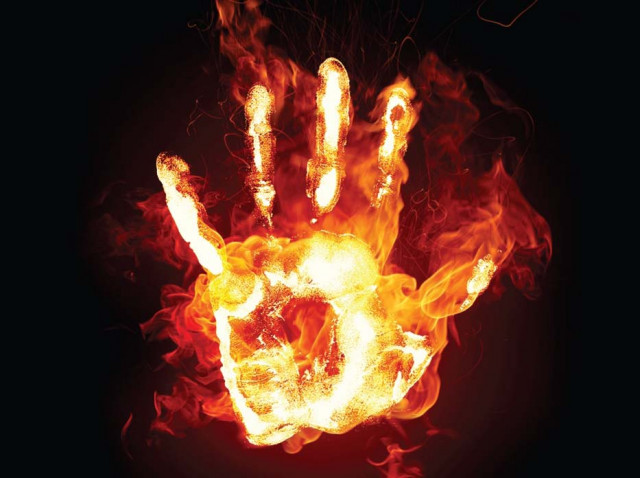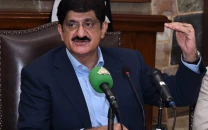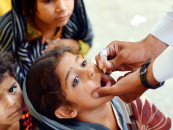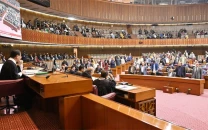Govt fails to fulfil seven-year-old promise to establish burns centres in various districts of Sindh
Centre at Civil Hospital, Karachi is only public facility in Sindh that treats burn patients

24-year-old university student suffered third-degree burns on 90% of his body, says PIMS Burns Centre medical staff. PHOTO:FILE
Out of all public sector hospitals across Sindh, the Civil Hospital, Karachi, is the only hospital catering to burn cases. "Many people who receive burn injuries lose their lives while travelling to Karachi, as there is no proper facility with trained doctors, paramedics, intensive care units or isolation wards to treat burns in any district of the province," an official of the health department said. The official added that in 2009 the government had allocated Rs182 million to establish burns centres at the Chandka Medical College Hospital, Larkana, Ghulam Mohammad Mahar College, Sukkur, Civil Hospital, Mirpurkhas, Liaquat Medical University, Jamshoro and Sindh Government Hospital in Liaquatabad, Karachi, but the plan could not be materialised.
"Soon after the funds were approved, the flood washed away the entire right bank of the Indus River in 2010 and those funds were diverted to flood victims. Since then, the burns centres plan has been in limbo," said a source.
Five succumb to burn injuries in Allied Hospital
In Larkana, which is the hometown of the Bhutto family and therefore a stronghold of the Pakistan Peoples Party, there is only one burns ward at the Chandka Hospital. The ward has only eight beds. One of the doctors at the hospital, requesting anonymity, told The Express Tribune that the ward lacks all basic fatalities, including equipment and instruments. "For burn victims, there should be separate operation theatres, intensive care units, recovery rooms, dressing rooms and sterilisation rooms. All these facilities are missing here," the doctor said. Reportedly, the same condition prevails at the burns ward of the government hospital in Hyderabad.
The medical superintendent of Chandka hospital, Dr Inayatullah Kandhro, maintained that they have one trained doctor and a dispenser to deal with burn cases at the ward. "We have now requested to relocate the burns ward of the hospital to the surgical ward where an air-conditioning facility is available and patients can be treated properly,” said Dr Kandhro. However, he accepted that the burn patients need special attention and isolation, which is not provided to them at the ward.
"We have no specific funds allocated for it and in case of emergency we refer all the patients to Civil Hospital, Karachi," Dr Kandhro said, adding that it takes seven to eight hours for patients to reach Karachi and many patients who require emergency treatment die while on the way to the city. In cases when the patients do not die, their cases often worsen in severity. "We can only provide first aid and refer more than 50% of burns patients to Karachi," he said, adding that none of the government hospitals in Sukkur, Jacobabad, Khairpur, Mirpurkhas, Tharparkar, Umerkot, Shikarpur or Dadu can deal with burn patients in cases of fire or road accidents.
Centre cuts scope of health insurance in Sindh, K-P
The Burns Centre at the Civil Hospital, Karachi, which is being managed by a non-governmental organisation, caters to burn patients from across Sindh. Centre incharge and senior plastic surgeon Dr Ehmeral Ibran told The Express Tribune that most government hospitals do not have proper skin grafting knives, skin graft masher carriers, ventilators and most importantly trained staff to deal with burns cases. "Burn treatment is totally different from routine medical cases and it is costly," he said, adding that it costs around Rs50,000 to treat a burn patient because of the expensive dressing and anti-biotic medicine used.
"There are first, second and third degrees of burns. In cases of severe burns, the body may lose a large quantity of fluid, which can disturb blood circulation. This is a very sensitive treatment, which needs proper care," Dr Ibran said.
"We have the capacity of 50 patients and can accommodate more in case of emergencies,” Dr Ibran said, adding that the centre provides medical facilities free-of-cost. “However, there is a dire need for establishing fully-equipped burns centres with trained staff at divisional levels,” he concluded.
The health minister and secretary were not available for comments.



















COMMENTS
Comments are moderated and generally will be posted if they are on-topic and not abusive.
For more information, please see our Comments FAQ